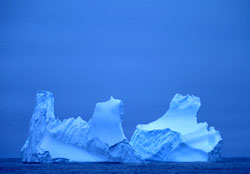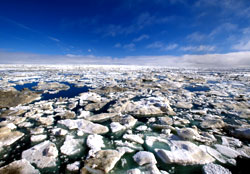|
|
 |
Images and Facts - Facts
Gallery | Dispatch Images | Facts | References
Sea Ice Glossary
by C. A. Linder
Arctic ice can be divided into two different types, classified by their method of formation. Icebergs are chunks of floating ice that have "calved" (broken off) from a glacier. Since they are formed from compacted snow, they are composed entirely of fresh water, like big floating ice cubes. The Greenland ice sheet and the Ellesmere, Devon, and Baffin Island glaciers in Canada account for the vast majority of arctic bergs. Since 90% of an iceberg is below the surface of the water, they travel with ocean currents and not the winds. Most bergs formed in Canada and Greenland stay in the eastern Arctic, eventually being carried into the Atlantic via Davis Strait and melting away.
 |  |  |
An iceberg in the
Irminger Sea. The part of the berg visible here is about the
size of a two storey home.
photo © C. A. Linder, WHOI |
Pack ice in the
Beaufort Sea (western Arctic). This is brash ice -- annual pack
ice in the process of melting.
photo © C. A. Linder, WHOI |
The other kind of arctic ice is pack ice. This kind of ice is formed
by the freezing of seawater. Seawater, because of the salt it contains,
freezes in a different manner compared to fresh water. The density
of seawater steadily increases as it cools, until reaching the freezing
point of around -2°C (although this depends on how salty the water
is). At the onset of winter, cold air chills the surface waters until
a relatively large layer of water at -2°C has formed on the surface.
A soupy cristalline mixture known as frazil ice begins to form in
the upper layer. As this soup thickens, a thin film of ice known as
grease ice forms. This film is strong enough to support the weight
of a seabird, and can ripple with the waves passing beneath. As the
surface temperature continues to drop, the ice forms a solid layer
and is then called pack ice. Ice that forms each winter and melts
each summer is known as annual ice, and is usually about six feet
thick. In the central Arctic, the ice never thaws completely in summer,
and thus it is known as multi-year ice. This ice ranges in thickness
from 15 feet to 25 feet. Why doesn't it just keep getting thicker
and thicker? Multi-year ice eventually enters an equilibrium where
the amount of new ice being formed on the bottom of the layer in winter
is exactly balanced by the loss due to melting off the top in summer.
Mariners have adopted a number of different names for icebergs and pack ice. The following glossary of ice terms is from Bowditch's Glossary of Marine Navigation.
Anchor ice. Submerged ice attached or anchored to
the bottom, irrespective of the nature of its formation.
Bergy bit. A large piece of floating glacier ice,
generally showing less than 5 meters above sea level but more than
1 meter and normally about 100 to 300 square meters in area. It is
smaller than an ICEBERG but larger than a GROWLER. A typical bergy
bit is about the size of a small house.
Blue ice. The oldest and hardest form of glacier
ice, distinguished by a slightly bluish or greenish color.
Brash ice. Accumulations of floating ice made up
of fragments not more than 2 meters across, the wreckage of other
forms of ice.
Bummock. A downward projection from the underside
of an ice field; the counterpart of a HUMMOCK.
Close pack ice. Pack ice in which the concentration
is 7/10 to 8/10, composed of floes mostly in contact.
Compact pack ice. Pack ice in which the concentration
is 10/10 and no water is visible.
Consolidated pack ice. Pack ice in which the concentration
is 10/10 and the floes are frozen together.
Fast ice. Sea ice which forms and remains attached
to the shore, to an ice wall, to an ice front, between shoals or grounded
icebergs. Vertical fluctuations may be observed during changes of
sea level. Fast ice may be formed in situ from the sea water or by
freezing of pack ice of any age to the shore, and it may extend a
few meters or several hundred kilometers from the coast. Fast ice
may be more than 1 year old and may then be prefixed with the appropriate
age category (old, second-year or multi-year). If it is thicker than
about 2 meters above sea level, it is called an ICE SHELF.
Fast-ice boundary. The ice boundary at any given
time between fast ice and pack ice.
Fast-ice edge. The demarcation at any given time
between fast ice and open water.
First-year ice. Sea ice of not more than one winter's
growth, developing from young ice, with a thickness of 30 centimeters
to 2 meters. First-year ice may be subdivided into THIN FIRST YEAR
ICE, WHITE ICE, MEDIUM FIRST YEAR ICE, and THICK FIRST YEAR ICE.
Floe. Any relatively flat piece of sea ice 20 meters
or more across. Floes are subdivided according to horizontal extent.
A giant flow is over 5.4 nautical miles across; a vast floe is 1.1
to 5.4 nautical miles across; a big floe is 500 to 2000 meters across;
a medium floe is 100 to 500 meters across; and a small floe is 20
to 100 meters across.
Floeberg. A massive piece of sea ice composed of
a hummock, or a group of hummocks frozen together, and separated from
any ice surroundings. It may float showing up to 5 meters above sea
level.
Firn. Old snow which has recrystallized into a dense
material. Unlike snow, the particles are to some extent joined together;
but, unlike ice, the air spaces in it still connect with each other.
Frazil ice. Fine spicules or plates of ice, suspended
in water.
Glacier ice. Ice in, or originating from, a glacier,
whether on land or floating on the sea as icebergs, bergy bits, or
growlers.
Glaze. A coating of ice, generally clear and smooth
but usually containing some air pockets, formed on exposed objects
by the freezing of a film of super cooled water deposited by rain,
drizzle, fog, or possibly condensed from super cooled water vapor.
Glaze is denser, harder and more transparent than either rime or hoarfrost
Also called GLAZE ICE, GLAZED FROST VERGLAS.
Grease ice. Ice at that stage of freezing when the
crystals have coagulated to form a soupy layer on the surface. Grease
ice is at a later stage of freezing than frazil ice and reflects little
light, giving the sea a matte appearance.
Grounded ice. Floating ice which is aground in shoal
water.
Growler. A piece of ice smaller than a BERGY BIT
or FLOEBERG, often transparent but appearing green or almost black
in color. It extends less than 1 meter above the sea surface and its
length is less than 20 feet (6 meters). A growler is large enough
to be a hazard to shipping but small enough that it may escape visual
or radar detection.
Hummock. 1. A hillock of broken ice which has been
forced upwards by pressure. It may be fresh or weathered. The submerged
volume of broken ice under the hummocks, forced downwards by pressure,
is called a BUMMOCK; 2. A natural elevation of the earth’s surface
resembling a hillock, but smaller and lower.
Hummocked ice. Sea ice piled haphazardly one piece
over another to form an uneven surface. When weathered, hummocked
ice has the appearance of smooth hillocks.
Iceberg. A massive piece of ice greatly varying in
shape, showing more than 5 meters above the sea surface, which has
broken away from a glacier, and which may be afloat or aground. Icebergs
may be described as tabular, dome shaped, pinnacled, drydock, glacier
or weathered, blocky, tilted blocky, or drydock icebergs. For reports
to the International Ice Patrol they are described with respect to
size as small, medium, or large icebergs.
Ice-blink. A whitish glare on low clouds above an
accumulation of distant ice.
Icefoot. A narrow fringe of ice attached to the coast,
unmoved by tides and remaining after the fast ice has moved away.
Land sky. Dark streaks or patches or a grayness on
the underside of extensive cloud areas, due to the absence of reflected
light from bare ground. Land sky is not as dark as WATER SKY. The
clouds above ice or snow covered surfaces have a white or yellowish
white glare called ICE BLINK.
Lead. A fracture or passage-way through ice which
is navigable by surface vessels.
Nilas. A thin elastic crust of ice, easily bending
on waves and swell and under pressure, thrusting in a pattern of interlocking
“fingers.” Nilas has a matte surface and is up to 10 centimeters in
thickness. It may be subdivided into DARK NILAS and LIGHT NILAS. See
also FINGER RAFTING.
Nipped. Beset in the ice with the surrounding ice
forcibly pressing against the hull.
Old ice. Sea ice which has survived at least one
summer’s melt. Most topographic features are smoother than on first-year
ice. Old ice may be subdivided into SECOND-YEAR ICE and MULTI YEAR
ICE.
Open pack ice. Pack ice in which the concentration
is 4/10 to 6/10, with many leads and polynyas, and the floes generally
not in contact with one another.
Pancake ice. Predominantly circular pieces of ice
from 30 centimeters to 3 meters in diameter, and up to about 10 centimeters
in thickness with raised rims due to pieces striking against one another.
It may be formed on a slight swell from grease ice, shuga, or slush
or as a result of the breaking of ice rind, nilas, or under severe
conditions of swell or waves, of gray ice. It also sometimes forms
at some depth, at an interface between water bodies of different physical
characteristics, from where it floats to the surface; its appearance
may rapidly cover wide areas of water.
Polynya. A non-linear shaped area of water enclosed
by ice. Polynyas may contain brash ice and/or be covered with new
ice, nilas, or young ice; submariners refer to these as SKYLIGHTS.
Sometimes the POLYNYA is limited on one side by the coast and is called
a SHORE POLYNYA or by fast ice and is called a FLAW POLYNYA. If it
recurs in the same position every year, it is called a RECURRING POLYNYA.
Rafted ice. A type of deformed ice formed by one
piece of ice overriding another.
Rotten ice. Sea ice which has become honeycombed
and is in an advanced state of disintegration.
Sastrugi, (sing. sastruga). Sharp, irregular ridges
formed on a snow surface by wind erosion and deposition. On mobile
floating ice, the ridges are parallel to the direction of the prevailing
wind at the time they were formed.
Sea ice. Any form of ice found at sea which has originated
from the freezing of sea water.
Shuga. An accumulation of spongy white ice lumps,
a few centimeters across, the lumps are formed from grease ice or
slush and sometimes from anchor ice rising to the surface.
Stranded ice. Ice which has been floating and has
been deposited on the shore by retreating high water.
Tabular iceberg. A flat-topped iceberg with length-to-height
ratio greater than 5:1. Most tabular bergs form by calving from an
ice shelf and show horizontal banding.
Tongue. A projection of the ice edge up to several
kilometers in length, caused by wind or current.
Very close pack ice. Pack ice in which the concentration
is 9/10 to less than 10/10.
Water sky. Dark streaks on the underside of low clouds,
indicating the presence of water features in the vicinity of sea ice.
Back to Facts Index
|
|




